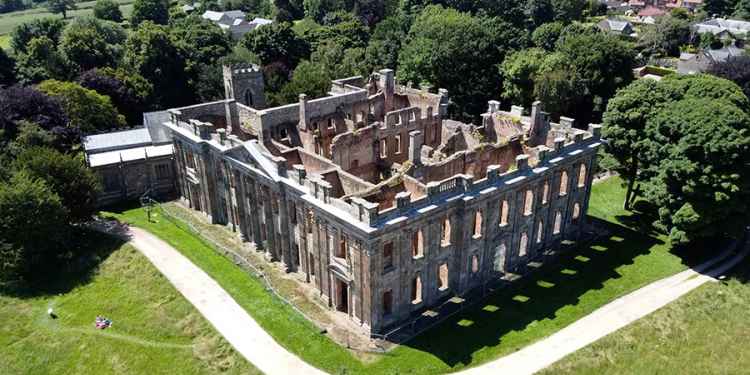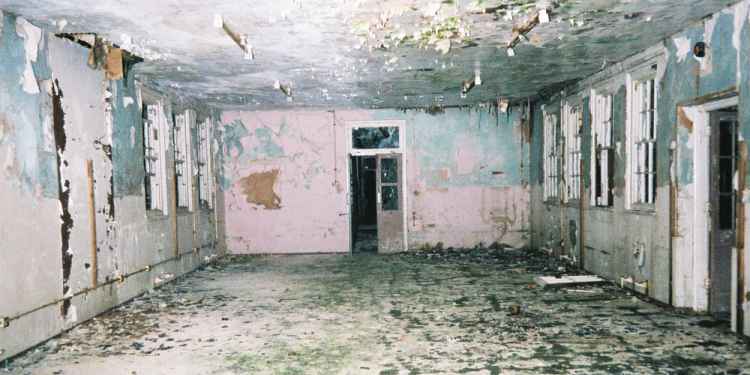
Photo: Pressmaster

Photo: Pressmaster
This page is more than four years old.
The paranormal world feels like it's growing at an incredible rate. Every year new paranormal shows appear in our television guides and the choice of locations now offering ghost hunting events is endless.
Of course people have had a healthy interest in the unknown for many years. When you think about ghosts you probably think of séances of the Victorian era and Harry Price taking paranormal investigation to the mainstream.
However, this isn't where the story begins. The earliest written records of hauntings go back at least 3,000 years earlier. Around the time Troy is believed to have fallen around. Hundreds of years later between 800-700 BC, the Greek poet Homer wrote the Iliad and Odyssey, which were thought to be vaguely based on the fall of the city.
The poems talk about ghosts, but says that they don't bother the living, and even though they plot and scheme, they are harmless and occasionally consoling. But, because these poems were based on events that took place hundreds of years before the author even lived, it's not known if the tales were based on first-hand experience, or simply legends.
By the time of the Greek philosopher, Socrates, in around 469-399 BC, people had started to fear ghosts. Ghosts were still thought to be helpful most of the time, but it was said that they could turn on the living and start to make demands. It was even believed that they might attack or kill someone who upset them.
At this time ghosts were thought to linger near their graves and that the ghost of someone who'd committed suicide, or died violently or prematurely was said to be especially dangerous to the living. It wasn't until at least 61 AD that hauntings got a little closer to home.
The first documented story of a haunted house was contained within a letter written by Pliny the Younger, a Roman magistrate. He described a villa in Athens which nobody was willing to move in to because of a ghost.
Part of the letter read, "in the dead of night, a noise like the clashing of iron could be heard. And if one listened carefully, it sounded like the rattling of chains. At first the noise seemed to be at a distance, but then it would approach, nearer, nearer, nearer. Suddenly a phantom would appear: an old man, pale and emaciated, with a long beard, and hair that appeared driven by the wind."
Later in the text the author wrote, "uninhabitable, the house was at last deserted, left to the spectral monster. But hope that some tenant might be found who was unaware of the malevolence within it, the house posted for rent or sale."
Are these hauntings really the spirit of the dead returning, or some other unexplained phenomenon. It wasn't really until the advent of modern spiritualism that people started to claim that they could make contact with ghosts, giving them the confirmation that they really were the spirits of the dead.
The movement started in 1848 in New York with a strange series of events involving two sisters. Kate, Margaret Fox were just 12 and 15-years-old when they moved with their family to a new house in an area that was known as Hydesville.
The girls soon came to the conclusion that their house was haunted after experiencing frequent unexplained sounds that they described as being like knocking.
One night, Kate asked the spirit to copy her when she snapped her fingers and it's reported that the spirit obliged, she then asked the ghost to tap out the ages of the girls, which again it got right. From here the girls developed the technique of responding to questions or indicating a letter of the alphabet with taps.
Over the next few weeks the girls determined that the spirit they were talking to, "Mr. Splitfoot", was the ghost of a market trader named Charles B. Rosna, they believed he'd been murdered five years earlier and buried in the cellar.
The nature of these allegedly intelligent communications was for many proof of ghosts and life after death. It gave birth to modern spiritualism. When Kate and Margaret's older sister, Leah started to promote them as mediums, they became famous as well-known mediums and some of the first spiritualists to publicly display their skills.
However, in 1888, Margaret and Kate confessed that their rappings had been a hoax and publicly demonstrated their methods. So, spiritualism had a shaky start, being founded on what was nothing more than a prank, but by this time the idea had been built on and séances were already common practice around the world - there was no stopping it.
In the late 1800s, when spiritualism was at its peak, séances were elaborate and entertaining performance pieces. The word séance comes from the French word for "session", from the Old French seoir, "to sit". Despite their popularity, sone refused to dabble. Christians and Jews are taught that it is sinful to attempt to conjure or control spirits.
Séances often included demonstrations of table tipping, musical instruments being played by spirit energy, the materialisation of ectoplasm, and even full apparitions.
Of course the aim of a séance was to communicate with spirits. At first table tipping was the preferred method of communication. Mediums demonstrated how spirits were supposedly able to move the table, but their audience eventually wanted more, they wanted to speak with the spirits.
The Fox sisters had conveniently created a method of spirit communication which allowed this and before long rapping was included in séances. This was later replaced by automatic writing, which involved the medium holding a pen and letting spirits take control of their hand in order to write an answers to questions.
Another popular séance tool, which is still used today, is the Ouija board. This was another way to allow mediums to keep their audiences entertained by allowing the spirits to spell out words and phrases in response to the sitters' questions.
Pushing things further forward, mediums began to allow spirits to speak through them. This was a phenomenon called channelling and is said to happen when a spirit takes control of the medium's vocal cords and spoke through their mouths.
Eventually the mediums were able to produce direct voice phenomenon. These are audible, disembodied voices, which are spoken directly to the sitter - not through a medium or any other intermediary. Usually the spirit's voice would seem to come from a point slightly above or to the side of the medium's head.
Originally séances were led by professional mediums, but over time those interested in the paranormal began to hold private séances and achieved similar results. Once normal people realised they could make contact with spirits themselves, it opened up the floodgates for ghost hunters and scientists aiming to validate claims of the existence of ghosts.
The paranormal shifted from being a form of entertainment, to a serious study and in 1882 the Society for Psychical Research (SPR) was founded in London. The society's members examined alleged paranormal activity and claims of psychic abilities using scientific methods. The society had author Sir Arthur Conan Doyle, psychoanalyst Sigmund Freud and psychiatrist Carl Jung amongst their numbers.
In the early days of investigations, researchers had to rely on the accounts of eyewitnesses and by analysing any photographs that were said to contain evidence of the paranormal. An investigation would often consist of an interview process, and an attempt to debunk and recreate any of the phenomenon reported, before writing a detailed paper on the case.
One of the society's most famous researchers, Harry Price, was the first paranormal investigators to experiment with a range of equipment. While investigating the famous Borley Rectory case between 1929 and 1938, he set up an on-site laboratory with equipment such as a portable phone, telescope, steel tape measures, cameras and fingerprinting equipment.
The equipment used has changed a lot in the last few decades as video cameras, including those with night vision, have become more affordable and due to the increasing number of electronic ghost hunting gadgets available - although the SPR advises against using these devices and instead recommends that investigators rely on their own senses, a camera and a notebook.
Despite these recommendations and advisories, ghost hunting today is becoming increasingly about electronic devices, most of which can detect atmospheric and environmental changes. The rise in paranormal groups, public ghost hunting events and television shows on the topic has seen a meteoric rise in the last few decades, spurred on in part by the growth of the internet.
Whatever method is used, the aim of modern ghost hunting is the same as that of the early forerunners - to capture evidence of the paranormal and ascertain whether it really is caused by the spirits of the dead, thus proving there is an afterlife.
But, after all these years, we are yet to answer some very basic questions about ghosts. What is a ghost? Why do spirits return? There are of course many theories and beliefs, but the truth is we'll probably never know for sure.
Ancient civilisations believed that ghosts returned to demand a proper burial so that they could rest in peace. This was the case with the spirit of the Roman emperor Caligula. After his murder he was cremated, but is said to have haunted the gardens where his ashes were buried. The haunting came to an end when burial rites befitting an emperor were finally performed.
Today, some say that ghosts return to pass on warnings, gratitude, comfort or advice to the living, or to seek revenge or right a wrong. Murdered victims are sometimes said to return to help the living find their killer and bring them to justice.
Although there are plenty of theories like these, and hundreds of thousands of documented experiences, nothing has moved us any closer to being able to answer the question once and for all do ghosts exist?
Learn With Higgypop
Hosted by Paralearning in association with Higgypop, these courses on ghost hunting, paranormal investigations, and occult practices draw on the experience of our team of paranormal writers.

Diploma In Capturing & Analyzing Electronic Voice Phenomenon
This course gives you practical and useful knowledge of ghost hunting and paranormal research, which is invaluable when conducting your own paranormal investigations or as part of a group event.
View Course
Diploma In Parapsychology & Psychic Phenomena
This course gives you practical and useful knowledge of ghost hunting and paranormal research, which is invaluable when conducting your own paranormal investigations or as part of a group event.
View CourseMore Like This

Haunted BritainDecember 25, 2024
2024's Most Popular Paranormal Hotspots In The UK

GamesNovember 28, 2024
Can You Match These Famous Ghosts To Their Haunting Grounds?

HalloweenOctober 30, 2024
Richard Felix Shares A Collection Of Modern Ghost Stories For Halloween

ParanormalOctober 20, 2024
My First Ever Ghost Hunt: 20 Years Ago This Halloween Night
 See More on Audible
See More on Audible

Comments
Want To Join The Conversation?
Sign in or create an account to leave a comment.
Sign In
Create Account
Account Settings
Be the first to comment.